|
| |
Back to private
aircraft
|
Italy |
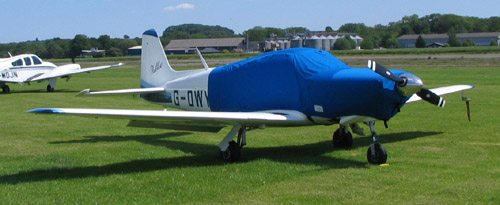 |
|
Hiding underneath these covers is the stylish Aviamilano F.14 Nibbio
(Kite). Designed unsurprisingly by Stelio Frati, it is essentially a
four seat version of the Falco (see under the homebuilt section).
Powered by a 180hp Lycoming O-360 engine, it has a top speed of over
200 mph and cruises at 185mph, putting it in the same class as
things like Bonanzas. It first flew in January 1958. I find it hard
to understand why only ten were built, and can only imagine that the
lovely aerodynamic refinement was too expensive to produce.
This is the only one in the UK, and was at
Shobdon in June 2006. |
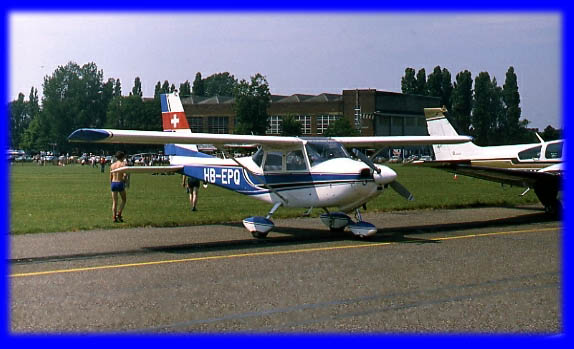 |
The Partenavia P64 Oscar looks rather like a
Cessna 172, but with a much taller tail. It first flew in April
1965. It is a four seat light touring aircraft. There are two main
versions, which differ in engine size (180 or 200hp). The similar
P.66 Oscar is a two seater with a choice of smaller engines (115 or
150 hp). It cruises at 135mph and has a range of 400 miles. It is 23
feet 3 inches long, with a wing span of 32 feet 9 inches and gross
weight of 2,050lb. Around 120 of all versions were built.
This one was at Cranfield in July 1984. |
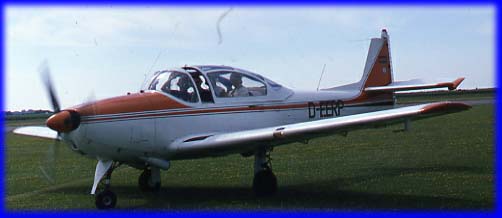
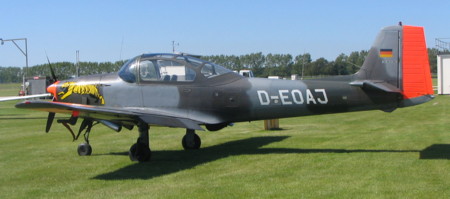 |
The Piaggio 149 was originally designed as a
four seat touring aircraft (the back seat can seat three at a pinhc,
making it a five seater), but the strength of the airframe and its
good handling qualities led to its being adopted as the standard
trainer for the German air force in the 1950s and 60s. Over 260 were
built, including 190 under license by Focke-Wulf in Germany as the
FWP.149D. Its 270hp Lycoming GO-480 engine gives it a top speed of
190mph and range of 680 miles. It is 28 feet 9 inches long, with
wing span 36 feet 6 inches. Gross weight is 3,700lb.
Top: Cranfield in July 1984.
Lower: Goodwood, August 2007 |
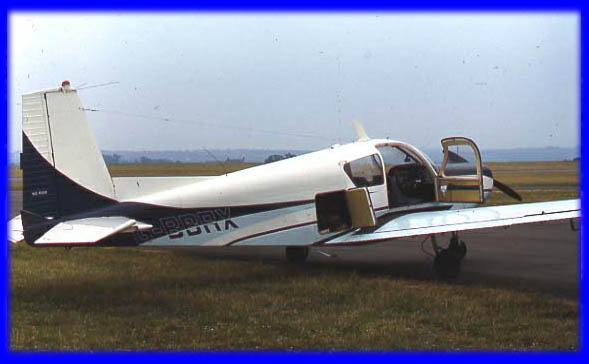
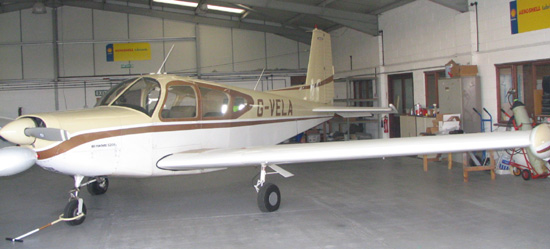 |
The SIAI Marchetti S205 is a stylish four
seat tourer produced in Italy during the 1960s and early 70s. It can
be equipped with a 180 or 200 horsepower Lycoming engine (though a
few have 220hp Franklin engines). It cruises at 160mph for a range
of 940 miles. It is 26 feet 3 inches long, with a wing span of 35
feet 7 inches. Gross weight is 2,865lb. About 500 were built.
The S.208 is basically similar except that its
more powerful 260hp Lycoming O-540 engine allows it to be a five
seater. S.208s are often equipped with extra fuel tanks on the wing
tips to maintain the range with the thirstier engine.
Top picture - S205 at Sunderland, July 1976.
Lower picture - S208 at Seething, December
2005. The registration is a reference to a version of the S208 which
was marketed in America as the Waco Vela. |
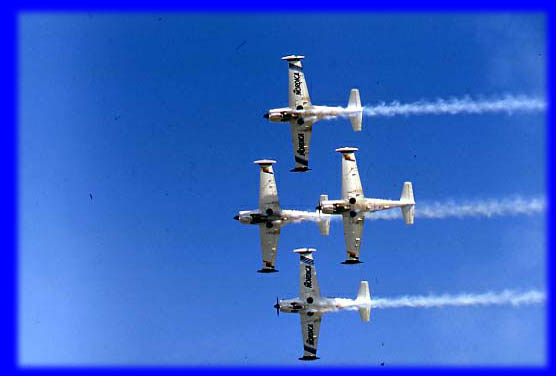
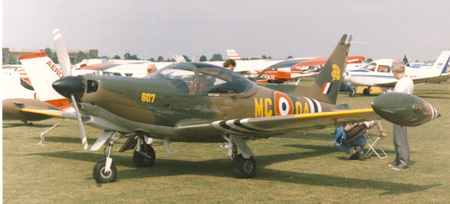
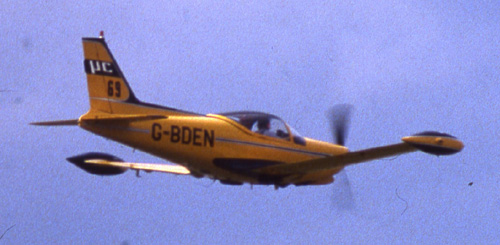 |
The SIAI Marchetti SF260 was designed by Dr
Ing Stelio Frati, who was responsible for some of the most beautiful
and elegant Italian light aircraft in the second half of the
twentieth century. It is a two or three seat aerobatic training
aircraft, which first flew in July 1964. Its 260hp Lycoming engine
gives it sparkling performance: it cruises at 215mph, range is 1,275
miles, and gross weight 2,430lb. It is quite compact, being 23 feet
long with a wing span of 26 feet 11 inches. It is not a cheap
aircraft but is popular as a trainer with airlines and many air
forces. The top picture shows four SF260s
displaying formation aerobatics at Yeovilton in July 1986. The
middle
picture is an SF260 at Cranfield, date uncertain. Bottom: SF260 in
an air race at Rochester, August 1985. |
|
Japan |
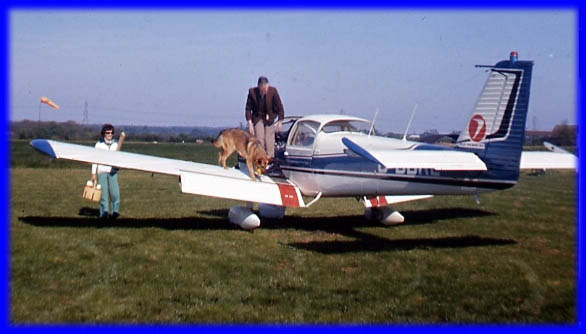 |
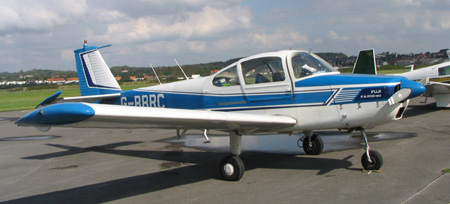 |
|
The Fuji FA200 Aero Subaru is unusual in
being one of the very few Japanese light aircraft to be built. It is
an all metal four seater, with basic aerobatic capability. It first
flew in August 1965. There are two versions, with either a 160hp or
180hp Lycoming engine. It cruises at about 110mph, has a range of
870 miles, and gross weight of 2,535lb. It is 26 feet 2 inches long,
with a wing span of 30 feet 11 inches.
The top picture is Georgina's favourite aircraft picture, because of
the dog!! It was taken by David's father in the mid 1970s.
The lower picture is of the same aircraft at
Le Touquet in November 2005. |
|
Poland |
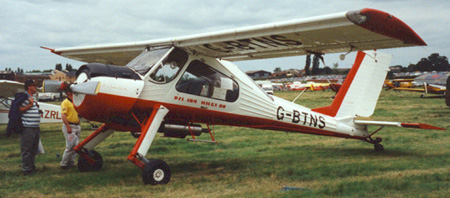 |
|
The PZL104 Wilga (Polish for Thrush) is one
of the more bizarre sights to grace the skies! A very agricultural
looking machine, its main advantage is an outstandingly short
take-off and landing roll. Powered normally by an Ivchenko AI-14
radial of 260hp, it is a four seater, but with a variety of
configurations for cargo, ambulance, glider towing and almost
anything else you can think of. It first flew in April 1962. It is
simple and robust, but (reputedly) not a joy to fly! It cruises at
up to 120mph and has a range of 410 miles; gross weight is 2,700lb.
It is 26 feet 6 inches long, with a wing span of 36 feet 5 inches.
It is also very awkward to get into because of the very high, stalky
undercarriage and the raked-back angle of the seats. Nevertheless,
over 850 have been made. It was still in production in the late
1980s. This one was at Cranfield, date
uncertain. |
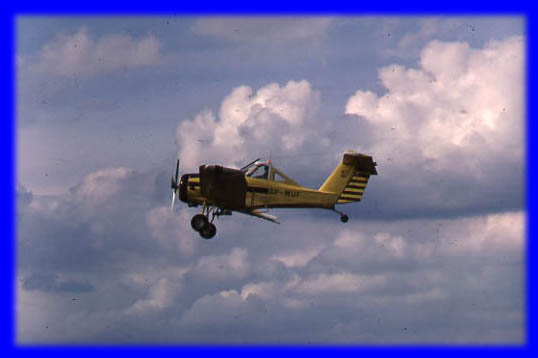 |
The PZL106 Kruk (Polish for Raven) is another
agricultural aircraft from Poland. Built like the Wilga at the PZL
factory at Okecie, near Warsaw, it first flew in 1973. Normal
powerplant is a 600hp PZL-3 seven cylinder radial, but even this
isn't enough for some people, and there is a version powered by an
amazing 1,000hp Shvetsov! Early Kruks had a T tail, but this was
replaced on later models with a low tail similar to the Dromader
(below). The Kruk is a single seater, with gross weight of up to
7,900lb, of which 2,600lb is chemical payload (and most of the rest
must be engine - those are the figures for the 1,000hp version). It
is 29 feet 10 inches long, with a wing span of 48 feet 10. Note the
slightly swept back wings. Several hundred have been built. This one was
demonstrated at Farnborough in September 1976. |
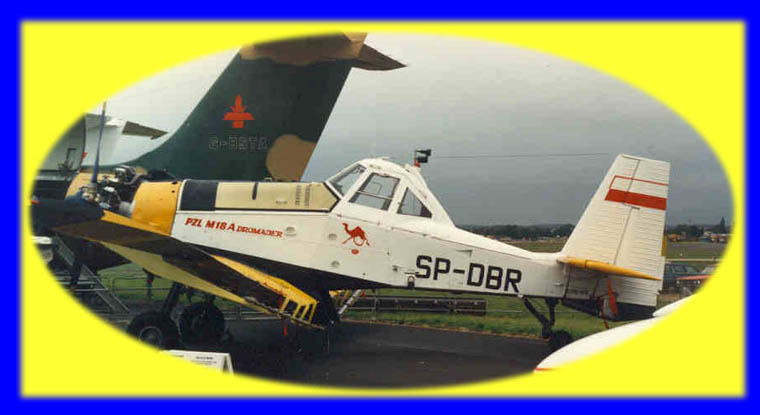 |
The PZL M-18 Dromader, built at PZL's factory
at Mielec, is superficially similar to the Kruk, but actually a
quite different aircraft. It first flew in August 1976. It is
powered by a 1,000hp PZL Kalisz nine cylinder radial engine, which
gives it a payload of 4,400lb of chemicals. It is a bigger aircraft
than the Kruk, being 31 feet 1 inch long, with a wing span of 58
feet. Maximum weight is 10,350lb. Over 300 have been built.
This one was at Farnborough in September 1986. |
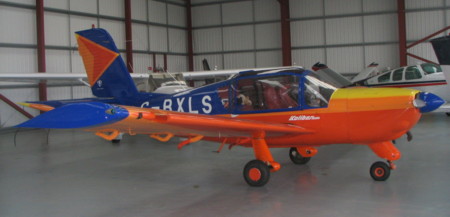 |
PZL Koliber
Gamston, November 2007 |
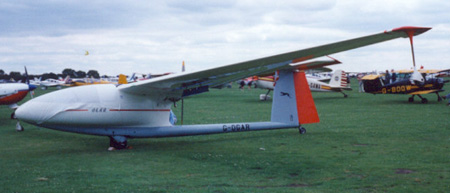 |
The SZD-45 Ogar is a powered glider, equipped
with a 65hp Limbach engine. As with all powered gliders it has a
very wide wing span, but the most obvious feature is the unusual
position of the engine and the very thin boom, passing under the
propeller arc, supporting the tail. It manages a sedate 50kt, but
with a fuel burn of only 9 litres per hour will stay up for a long
time - even longer with the engine off and a few thermals about.
Cranfield, 1998 |
|
Romania |
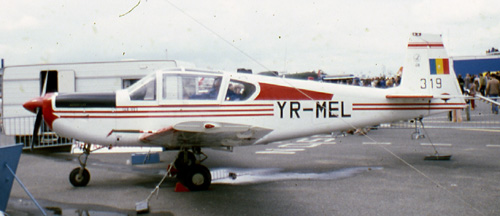 |
|
The IAR823 is a five seat touring aircraft,
also often used as a trainer, built at Brasov by Intreprinderea de
Constructii Aeronautice (ICA). It is powered by a 290hp Lycoming
IO-540 engine, which gives it a cruising speed of 175mph and range
of 800 miles. It has retractable undercarriage and, unusually for
its class, is fully aerobatic. It first flew in July 1973.
This one was at Paris in June 1981. |
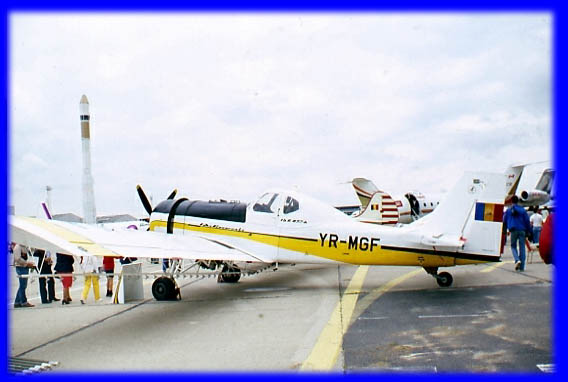 |
The IAR827 is Romania's chunky agricultural
aircraft. Its 600hp PZL-3S seven cylinder radial engine gives it a
gross weight of 6,200lb, of which 2,000lb is chemical load.
Unusually for an agricultural aircraft, it is a two seater; the
second seat being intended for a mechanic. I am not sure whether
that demonstrates first rate attention to operators' needs or a lack
of confidence in its reliability! It is 28 feet 10 inches long, with
a wing span of 45 feet 11 inches. This
one was demonstrated at Paris - Le Bourget, June 1981. |
|
Russia |
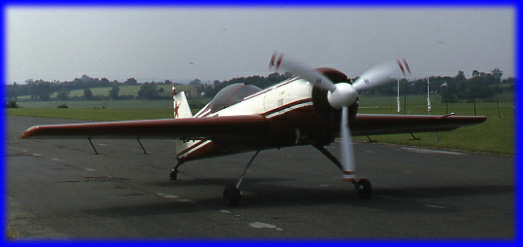 |
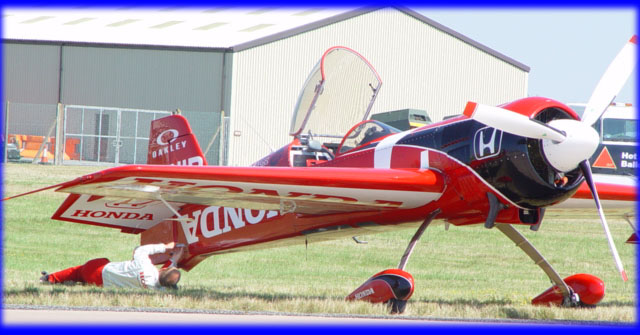 |
The Sukhoi Su26 is a world class competition
aerobatic aircraft, designed by the bureau of Pavel Osipovich Sukhoi
- more normally associated with high performance large jet combat
aircraft. It has first class performance; its 360hp Vedneyev nine
cylinder radial engine provides enough power for every reasonably
forseeable move, and enough torque for very impressive gyroscopic
manoeuvres. It first flew in June 1984. It is a compact machine, 22
feet 2 inches long, with a wing span of 25 feet 4 inches. Over 70
have been built. Top - an Su26 at South
Cerney in August 1986. Lower - Su26 of the Honda aerobatic team at
Fairford, July 2005. |
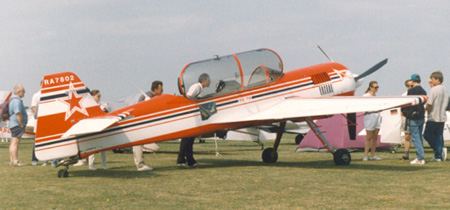 |
The Sukhoi Su29 is essentially a two seat
version of the Su26, which first flew in 1991. It is more powerful
(400hp), slightly longer (23 feet 9 inches) and with a wider span
(26 feet 9 inches) than its single seat forebear, and very slightly
slower (top speed is 275mph). It is, nevertheless, a highly capable
performer.
This one was at
Cranfield, date uncertain |
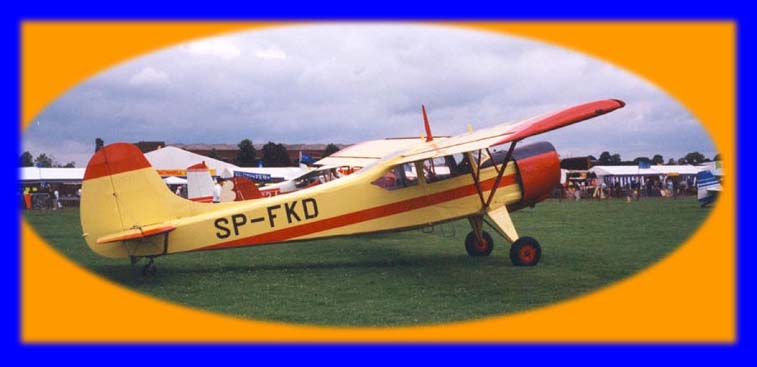 |
The Yakovlev YAK12 (NATO codename Creek) is a
four seat workhorse whcih provided the backbone of light liaison
services in the USSR for many years since its first flight in 1947.
Initial versions were powered by a 160hp M-11 radial, but this was
replaced on later aircraft with a 260hp Ivchenko AI-14. Top speed is
135mph and range is 670 miles. It is quite a big aircraft, 29 feet 6
inches long, with a wing span of 41 feet 4 inches. A massive 3,800
were built in Russia, and a further 1,190 under license in Poland.
This one at Cranfield in 1998. |
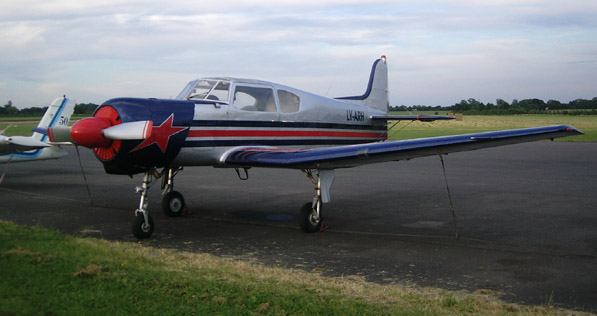 |
The Yakovlev YAK18T (Nato codename Max) is a
four seat derivative of the YAK18 two-seat trainer. Its 355hp
Vedneyev M-14 nine cylinder radial engine gives it a top speed if
175mph and range of 640 miles. Gross weight is a massive 3,640lb.
Around 200 were built following its first flight in 1967. It is a
big aircraft, 27 feet 7 inches long, with a wing span of 36 feet 7
inches. Following withdrawal from Soviet military use, many have
found their way into private hands, including this one, seen at
Turweston in July 2005. |
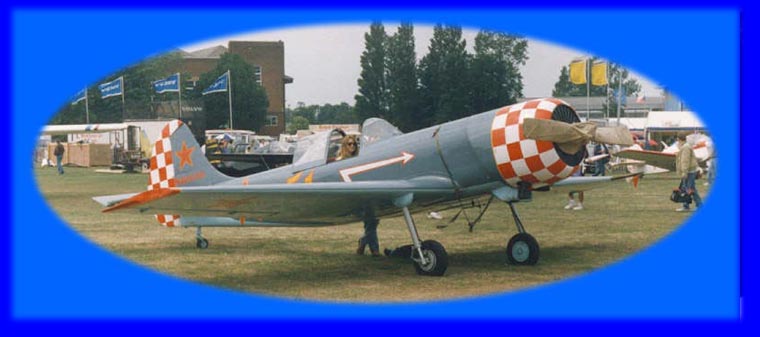 |
The Yakovlev YAK50 is another Russian
competition aerobatic aircraft, this time from the bureau of
Alexander Yakovlev. The Yak50 can trace its lineage to the Yak3
fighter of the second world war, via the Yak11 trainer and the
Yak18. The 50 principally differs from the Yak18 trainer in its new
wing (note the absence of a kink a foot or so from the wing root)
and in having an entirely metal skin; it is also a single seater. It
is powered by the same Vedneyev M-14 radial engine, which gives it a
top speed of 200mph, range of 345 miles and gross weight of 2,130lb.
It is 25 feet 7 inches long, with a wing span of 31 feet 2 inches.
It first flew in 1972, since when 310 were built.
This one was at Cranfield, date uncertain. |
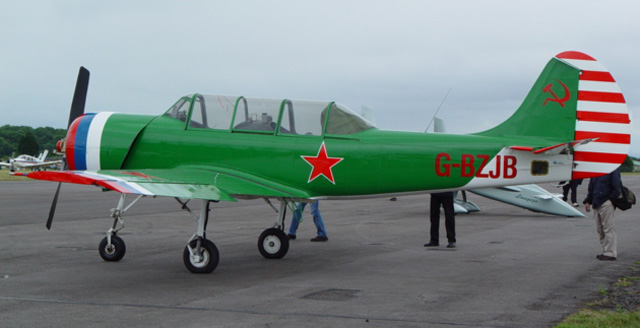 |
The Yakovlev YAK52 is essentially a two seat,
tricycle undercarriage version of the Yak50, built for use as an
aerobatic trainer. It first flew in 1976, and over 1,800 were built,
mostly as trainers for the Soviet Air Force. It is a heavier
machine, grossing 2,890lb, but slightly faster than the Yak50,
having a top speed of 220mph. Range is 310 miles. It is a very crisp
and responsive machine to fly, especially in roll. A couple of odd
characteristics (for those brought up on Pipers and Cessnas) are the
brake and undercarriage systems, which are driven by compressed air,
and the vanes on the front of the cowling which manage cylinder head
temperature by adjusting cooling airflow.
This one was at Kemble in July 2005. |
|
Sweden |
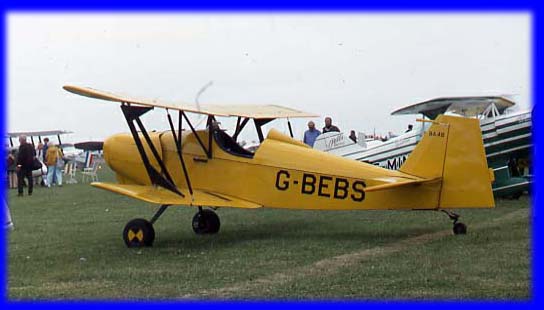 |
|
The Andreasson BA4B single seat biplane was
designed by Swedish engineer Bjorn Andreasson (later responsible for
the Bolkow Junior). It is widely available as a homebuilt design,
for which it can have a variety of engines, though there are some
series built examples about fitted with a 100hp Rolls-Royce
Continental. This gives is a creditable cruising speed of 120mph.
Its small size (115 feet long, 7 feet 7 inch wing span) and low
weight (825lb) preclude it carrying much fuel, so range is only 175
miles. This one was at Cranfield, date
uncertain. |
|
Switzerland |
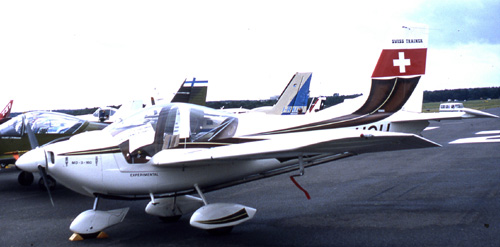 |
|
The Datwyler MD-03 is a small two seat
trainer designed in Switzerland but assembled by SME in Malaysia,
who have named it the Aero Tiga. Powered by a 160hp Lycoming O-320
engine, it has a top speed of 150mph, range of 680 miles and gross
weight of 1,850lb. It first flew in 1983. I am not sure how many
have been built, but it is probably about 20, mostly as trainers for
use in Malaysia and Indonesia.
This one was at
Farnborough, September 1984 |





|